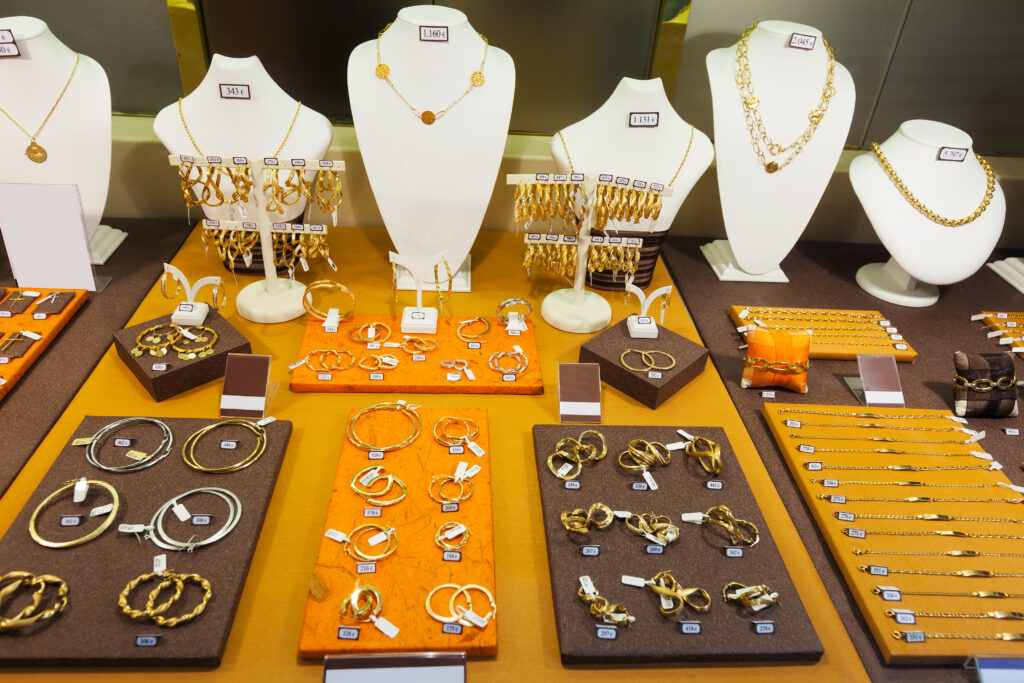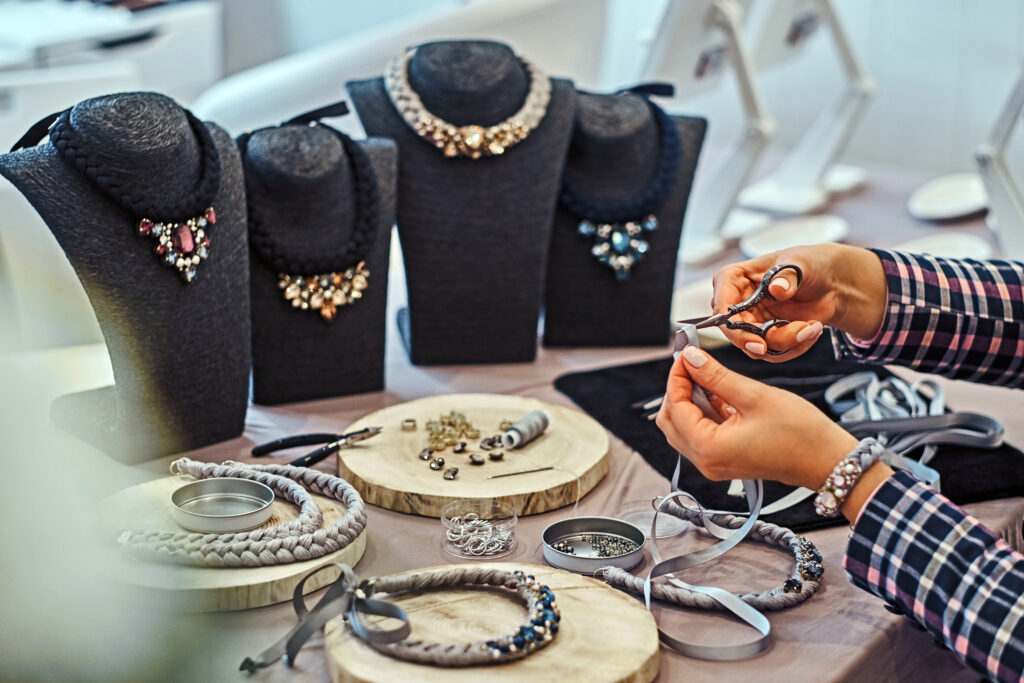Defining Sustainable Jewelry
Exploring the concept of Sustainable Jewelry and its significance in the context of ethical practices and environmental conservation.
Ethical Sourcing: Shaping Responsible Supply Chains
- Fair Trade Practices: Understanding the importance of fair wages and working conditions for miners and artisans.
- Conflict-Free Materials: Examining the efforts to eliminate the use of materials linked to conflict zones and human rights abuses.
- Transparency and Traceability: How brands are embracing transparency in their supply chains to ensure accountability.
Environmental Impact: Redefining Responsible Practices
- Recycled Metals and Gemstones: Highlighting the growing trend of using recycled materials to reduce mining’s ecological footprint.
- Low-Impact Mining Initiatives: Exploring initiatives promoting responsible mining practices and minimizing environmental harm.
- Innovative Eco-friendly Materials: Showcasing alternative materials like lab-grown diamonds and eco-friendly metals.
Design and Innovation: Marrying Style with Sustainability
- Creative Designs with Purpose: How jewelry designers incorporate sustainability into their aesthetic visions.
- Modular and Versatile Jewelry: Exploring designs that offer versatility, reducing the need for multiple pieces.
- Upcycling and Repurposing: Embracing creativity by repurposing old or unused jewelry into new, unique pieces.
Consumer Awareness and Impact: Empowering Through Choices
- Educating Consumers: The role of consumer awareness in driving demand for sustainable jewelry.
- Supporting Ethical Brands: Encouraging consumers to prioritize brands committed to sustainable practices.
- The Power of Circular Fashion: Embracing a circular economy mindset by promoting recycling and longevity of jewelry pieces.
Challenges and Future Prospects: Paving the Way Ahead
- Challenges in Adoption: Addressing hurdles in widespread adoption of sustainable practices in the jewelry industry.
- Technological Advancements: How technology can further revolutionize sustainable jewelry production.
- The Road Ahead: Envisioning a future where sustainability becomes the norm in the jewelry industry.
Conclusion: The Brilliance of Sustainable Jewelry
Summarizing the transformative impact of sustainable practices in the jewelry industry and the collective responsibility in shaping a more ethical and environmentally conscious future.
Sustainable Jewelry: A Sparkle with Purpose

Jewelry has long been synonymous with beauty, elegance, and luxury. However, the conventional jewelry industry has often been associated with ethical concerns and environmental impacts stemming from mining practices, labor exploitation, and resource depletion. In response, a transformative movement towards sustainable jewelry has emerged, reshaping the industry’s landscape.
Ethical Sourcing: Shaping Responsible Supply Chains
One of the cornerstones of sustainable jewelry is ethical sourcing. Brands are increasingly prioritizing fair trade practices, ensuring that miners and artisans receive fair wages and work in safe conditions. Additionally, efforts to eliminate conflict materials, which have fueled violence in some regions, are gaining momentum. Transparency and traceability in supply chains are becoming pivotal in holding brands accountable for their sourcing practices.
Environmental Impact: Redefining Responsible Practices
The environmental impact of jewelry production cannot be overlooked. To mitigate this, the industry is turning towards recycled metals and gemstones, reducing the need for new mining while minimizing environmental harm. Initiatives promoting low-impact mining practices aim to ensure responsible extraction. At the same time, the exploration of alternative materials, such as lab-grown diamonds and eco-friendly metals, offers sustainable alternatives to traditional resources.
Design and Innovation: Marrying Style with Sustainability
Sustainable jewelry doesn’t compromise on aesthetics. Designers are embracing creativity while integrating sustainability into their designs. Modular and versatile jewelry pieces are gaining popularity, offering consumers the flexibility to style one piece in multiple ways, reducing the need for excessive purchases. Moreover, upcycling and repurposing old or unused jewelry into new, distinctive pieces showcase the industry’s commitment to creativity and sustainability.
Consumer Awareness and Impact: Empowering Through Choices
Educating consumers about the impact of their choices is pivotal in driving demand for sustainable jewelry. By prioritizing brands committed to ethical practices, consumers wield significant influence in shaping the industry’s direction. Embracing circular fashion principles—where items are recycled, repaired, or passed on—encourages a more sustainable and mindful approach to consuming jewelry.
Challenges and Future Prospects: Paving the Way Ahead
Despite the strides made, challenges persist in widespread adoption. The cost of sustainable practices, consumer education, and industry-wide collaboration remain hurdles. However, technological advancements offer promising solutions. Innovations in recycling techniques, blockchain for supply chain transparency, and advancements in lab-grown gems present opportunities for a more sustainable future.
The Brilliance of Sustainable Jewelry
The evolution towards sustainable jewelry marks a transformative journey—a journey that aligns the beauty of adornment with ethical and environmental responsibility. The collective efforts of consumers, brands, and the industry at large will determine the course toward a future where the sparkle of jewelry resonates not just with beauty but also with purpose, ethics, and sustainability. As we embrace sustainable jewelry, we illuminate a path toward a more conscious and brilliant future.
The Rising Consumer Consciousness
Consumer awareness continues to play a pivotal role in propelling the sustainable jewelry movement forward. With increased access to information, today’s consumers are more informed and conscientious about the origins of their purchases. This shift in mindset has catalyzed a demand for transparency and accountability from jewelry brands. Educating consumers about the impact of their choices empowers them to make informed decisions, fostering a culture of conscious consumption.
The Role of Ethical Brands

Ethical jewelry brands serve as beacons in the industry, showcasing their commitment to sustainable practices. These brands prioritize transparency, ensuring that their supply chains adhere to ethical sourcing standards and environmental responsibility. By supporting such brands, consumers reinforce the importance of ethical and sustainable practices, encouraging the wider industry to follow suit.
Overcoming Challenges and Embracing Innovation
The journey towards widespread adoption of sustainable practices in the jewelry industry is not without obstacles. Cost considerations, scalability of sustainable methods, and the need for continued innovation pose challenges. However, technological advancements offer promising solutions. Innovations in recycling techniques, blockchain-enabled traceability, and advances in lab-grown gems present opportunities to overcome these hurdles.
The Promise of a Sustainable Future
The jewelry industry’s pivot towards sustainability heralds a future where beauty harmonizes seamlessly with ethical considerations and environmental stewardship. As stakeholders across the spectrum—consumers, brands, miners, and policymakers—collaborate and advocate for sustainable practices, the trajectory of the industry veers towards a more responsible and conscious path.
Celebrating Sustainable Success Stories
Several trailblazing initiatives and brands have led the charge in redefining the jewelry industry’s ethical and environmental standards.
- Brilliant Earth: This brand ethically sources its diamonds and gemstones, ensuring that they are conflict-free and come from responsible mining sources. Their commitment to transparency and sustainability sets a benchmark in the industry.
- Pippa Small: Renowned for her designs that embrace artisanal craftsmanship and fair trade practices, Pippa Small champions ethical sourcing and empowers local communities through her jewelry creations.
- Lab-Grown Gems: Innovators in the field of lab-grown diamonds and gemstones, like Diamond Foundry and Chatham, offer sustainable alternatives to traditionally mined stones, reducing the environmental impact associated with mining. More information.
